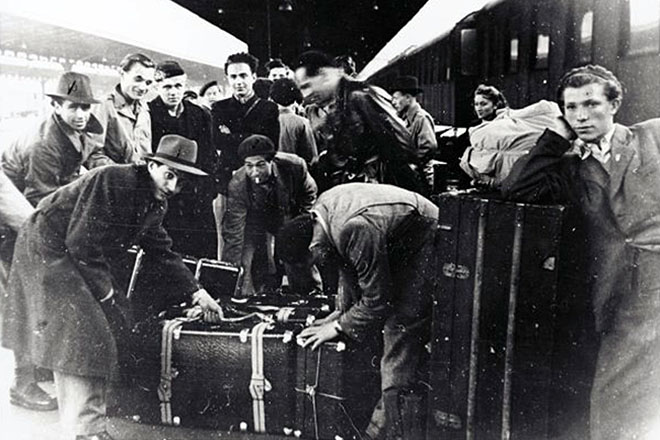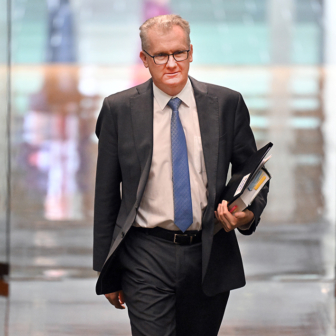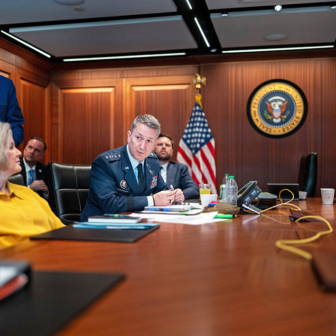On 9 and 10 November 1938, Nazi stormtroopers, sometimes aided by ordinary citizens, burned down more than a hundred synagogues in Germany and Austria in an orchestrated nationwide pogrom. They took thousands of Jewish men to concentration camps, partly in order to increase the pressure on them and their families to emigrate.
In Australia, news of the pogrom strengthened the position of organisations arguing for a liberalisation of the country’s immigration policy. In fact, support for the admission of Jewish refugees now came from an unexpected quarter: on 18 November the NSW Trades and Labour Council, which had traditionally opposed immigration, passed a resolution asking the government to accept Jewish refugees and, if necessary, to support them financially.
From London, Australia’s high commissioner, former prime minister Stanley Bruce, told the government on 21 November that “strong feeling is rapidly developing” that an unprecedented international effort was required to deal with Jewish refugees from Germany, and that Australia might find itself in an “embarrassing situation” if it did not make a statement regarding its approach. He was not so much guided by humanitarian considerations as by concerns about Australia’s reputation, particularly in the United States and the United Kingdom. He suggested that Australia announce a quota of 30,000 refugees over three years.
Cabinet agreed to Bruce’s proposal in principle but halved the figure. On 1 December interior minister John McEwen announced the new policy (which had been approved by cabinet the previous day) in parliament. He said that Australia would admit up to 15,000 refugees from Europe over three years. “The government feels that, if a solution of this problem is to be found, countries must be prepared to receive a proportion of those to be expatriated, in relation to the capacity of the countries to assimilate them,” he explained.
But McEwen’s announcement came with two important provisos. The first was that refugee policy was not to trump Australia’s broader immigration policy:
Although the refugee problem is one quite apart from the general question of immigration, in that it deals with the specific question of the amelioration of the conditions of oppressed people, at the same time it is essential that it should be considered in relation to the general question of immigration so far as the Commonwealth is concerned.
The second proviso was that the specific circumstances of applicants were not to be taken into account: “Desperate as is the need of many of those unfortunate people, it is not the intention of the government to issue permits for entry influenced by the necessity of individual cases.”
There was some grumbling among McEwen’s colleagues and in the press, but in federal parliament the new policy had bipartisan support, although it was obvious that the government and the opposition agreed to the admission of refugees for different reasons; in response to the minister’s announcement, opposition leader John Curtin declared: “Australia is a place where lovers of liberty should be welcome.”
While McEwen made Australia’s quota public, he did not provide any detail about its likely composition; most importantly, he did not reveal that the government had also agreed to limit the number of Jewish immigrants accepted under the quota to 4000 per year, and that it had decided that the quota “may be exceeded in admitting approved Aryans.”
Bruce was disappointed by the government’s decision to halve the numbers suggested by him, but thought 15,000 was a “respectable” figure. The announcement received a positive response in London, as Bruce had intended. The Times referred to a “characteristically generous contribution” and opined in an editorial that “[t]he Commonwealth government have certainly done their full share.” According to the paper, “A great part of their wide territory is uninhabitable; their chief cities are crowded, and the majority of the immigrants are unlikely to be acquainted with agriculture or stockraising.” In a similar vein, the Observer wrote that the decision was a “striking illustration of how noble compassion can circle the globe.”
Both in Australia and overseas the announcement was read as an indication that Australia was now making a significant contribution to alleviating the refugee crisis caused by Nazi Germany’s racial policies. Observers did not draw attention to the policy’s doubleedged nature, which allowed for the admission of 15,000 refugees but also effectively restricted the number of refugees entering Australia by setting an upper limit on the number of applications that would be approved from people identified as refugees, irrespective of how many of them met all of Australia’s criteria.
After the war, the newly formed immigration department established that 1556 refugees had arrived in 1938, and 5080 the following year. These figures are an underestimate because the government statistics only captured the number of migrants entering Australia who were identified as refugees. Given that the chances of applicants being issued with landing permits were greater if they managed to hide their precarious circumstances, there were probably scores of people from Central Europe who entered Australia disguised as “ordinary” migrants. Others ostensibly arrived as tourists.
Taking into account the overall migrant arrivals from Germany, Austria, Czechoslovakia and Poland between 1933 and 1939, I estimate the number of refugees admitted by Australia in the 1930s to be closer to 10,000. That number is significant when compared to Australia’s intake of nonBritish migrants in the aftermath of the Great Depression, but small when considered in the context of the size of the refugee problem in Europe.
In comparison with other countries, Australia was not particularly miserly; in fact, it was a little more generous than others. New Zealand, whose population at the time was slightly less than a quarter of Australia’s, admitted only about 1100 refugees from Europe. The Canadian government only let in refugees with farming credentials, which excluded almost all Jewish refugees from Germany and Austria; between 1933 and 1945, Canada admitted fewer than 5000 Jewish refugees.
Australia was reluctant to admit Jewish refugees, and opposed to the immigration of Jewish refugees from countries other than Austria and Germany. In that, too, it was not alone; in fact, Australia’s reservations were mild in comparison to those of Canada. According to the historian Paul Bartrop, Canada’s policy was partly shaped by an “anti-Semitic director of immigration, a disinterested minister [and] an indifferent prime minister with antiJewish leanings.”
It is often assumed that a government’s refugee policy comprises two elements: its approach towards the alleviation of refugee crises by providing financial or material assistance (for example, by funding emergency relief administered by the Red Cross), and its approach towards the resettlement of refugees. It is easy to lose sight of another option governments might have: namely, to tackle refugee problems at their source.
Thus, in recent years the Australian government, which has tried to deter Tamils from attempting to seek asylum in Australia and has collaborated with the Sri Lankan government to prevent prospective asylum seekers from leaving Sri Lanka by boat, could have instead focused its efforts on persuading the government in Colombo to afford ethnic Tamils the same rights, privileges and recognition that are enjoyed by ethnic Singhalese. Yet successive Australian governments have often appeared to condone human rights violations in Sri Lanka, perhaps in the interest of maintaining a friendly relationship with their Sri Lankan counterparts.
Australia’s response to the German refugee crisis might also be evaluated in this light. Particularly after the pogroms of November 1938, the Australian government received many letters from individuals and organisations demanding that something be done to make Nazi Germany desist from persecuting Jews. The government’s standard reply was that “the Commonwealth government considers that no good purpose would be served were a formal protest to be made to the German government in connection with the treatment of Jews in Germany.” In that respect, too, Australia was in good company; other governments were also most reluctant to respond in ways that could be seen as interference in the internal affairs of a sovereign nation.
The suggestion that such interference might be necessary, however, was widely discussed. In December 1935 James G. McDonald, the League of Nations high commissioner for refugees, resigned from his position, having become increasingly frustrated by the constraints within which he had to operate. He used a carefully crafted letter of resignation to demand that the root causes of the forced displacement of Jews from Germany be addressed.
The Australian government’s approach ought to be seen also in the context of the overall Australian response to the European refugee crisis. Refugees had their lobbyists, but these did not wield much influence and represented only a small minority of Australians. As the Hungarian refugee Emery Barcs (who migrated to Australia in 1939 after the introduction of antiSemitic racial laws in his native Hungary) observed, the antirefugee sentiment was pervasive, even though Australians displayed “little overt hostility” towards refugees. The newspapers – with one notable exception, the Sydney Morning Herald – were largely unenthusiastic about the admittance of refugees.
Some key professional organisations were opposed either to letting European refugees in or to letting them use their qualifications and skills. The Musicians’ Union of Australia, for example, opposed the admission of refugees outright. Their secretary conceded that Australia might benefit from the immigration of a select number of orchestral musicians, but declared that his union only approved of musicians from Britain. In a recent book, Kay Dreyfus has told the story of the Weintraub Syncopators, who became famous as the onstage band in the 1930 von Sternberg film The Blue Angel, and who arrived in Australia in 1937. All bar one were Jewish, and were therefore not able to return to Germany, where most of them had grown up. According to Dreyfus, the Musicians’ Union fought a long and bitter battle to prevent the Weintraubs from securing employment in Australia or even becoming permanent residents.
The Australian Dental Association, on the other hand, did not object to the immigration of European refugees, but required German and Austrian dentists to enrol in the third year of a fouryear dentistry degree. A spokesman for the association justified this measure by saying that he had been “amazed at the low standard of dentistry required in Germany.” One of Vienna’s leading dental surgeons, who practised his profession without registration, commented dryly, “I have neither the time nor the money to attend their silly school, which is fifty years behind the times, anyway.”
Selfinterest drove some Australians to welcome the arrival of refugees. In January 1939 the general secretary of the United Graziers’ Association of Queensland wrote to the government “to ascertain what percentage of female domestics would be amongst these refugees and whether any would be available for country districts in Queensland to serve in the capacity of domestic servants.” Such exceptions aside, the general public and the press were overwhelmingly not in favour of the admission of sizeable numbers of refugees, particularly if they were Jewish. Frequently, the papers reported xenophobic or antiSemitic views without dismissing them as inappropriate.
Some political leaders, when complaining about the admission of Jewish refugees, employed the same kind of language that German Nazis used. For example, in 1939 Frank Clarke, president of the Victorian Legislative Council and a former state government minister, referred to Jewish refugees as “weedy East Europeans” and “slinking, ratfaced men under five feet in height.” Still, public sentiment before the outbreak of the war never resembled antialien hysteria; most Australians simply did not care.
In 1938 the government had tried to impose limits on the number of Jewish refugees arriving in Australia by the same ship. In April it had allocated 500 places for Jewish immigrants to the Australian Jewish Welfare Society, “with the proviso that no more than twenty sponsored cases arrive on any one ship.” Also that year, the government advised German travel agents not to accept more than twenty bookings per ship from refugees, but it knew it could not enforce this policy.
The attempt to restrict numbers was motivated not so much by the government’s unwillingness to accommodate refugees as by the expectation that mass arrivals would prompt a public backlash: “When large numbers arrive by boat… Press immediately gives prominence to the fact and strong representations for curtailment of issue of permits are made,” the Prime Minister’s Department advised the office of the Australian high commissioner in London in November 1938. “It would be in the interests of the Associations connected with the refugees that they do everything possible to prevent large numbers arriving by one boat.”
As the number of refugees issued with landing permits increased in 1938, it was obvious that passenger ships arriving from Europe would often carry far more than twenty people fleeing Germany and Austria. A ship with a particularly large contingent of refugees on board was the mail liner Strathmore, which docked in Fremantle on 16 May 1939. The Perth Daily Mail noted that the ship brought “320 aliens,” many of them “fleeing refugees,” to Australia, and singled out three of them on account of their skills or fame. Other papers were more specific, providing information about the number of Jews among the aliens. In a later edition, the Daily Mail published a feature article about Nazi policy and fashion in Germany, which drew on information provided by one of the refugee passengers. In other newspaper articles, individual refugees were featured among other, British or Australian, passengers.
The overwhelmingly positive response gave way to a more ambivalent attitude when, a few days after the ship’s arrival, eight of the Strathmore’s Australian passengers wrote an open letter in which they complained about the refugees on board the ship. They claimed their encounters during the voyage had made them revise their “sympathetically inclined views towards European refugees.” According to the letter, the refugee passengers were able “to spend extravagantly upon luxuries for themselves,” which was inconsistent “with their povertypleading appeals,” most of them had no intention of “becoming Australians at heart,” and they were “definitely not the type of citizen Australia requires.”
This letter was reported without comment in several newspapers, but the response to these allegations varied. They prompted at least one letter to the editor whose author, another Australian Strathmore passenger, refuted them, and the Sydney Sun, rather than reporting them, published a detailed and sympathetic article about one of the refugees on board the Strathmore, who expressed his joy at having arrived in Australia.
It is important to keep the overall response to the ship’s arrival in perspective. The allegations neither triggered nor accompanied a broader debate about the admission of European refugees to Australia. Compared to the controversies prompted by the arrival of “boat people” in 2001 and between 2008 and 2013, public discussions about the arrival of European refugees in the late 1930s were remarkably lowkey. They also paled in comparison to the public outcry that accompanied the arrival of Jewish Holocaust survivors in late 1946 and early 1947.
After the war, the Strathmore once again plied the route between Britain and Australia. With shipping capacity limited, Australian servicemen’s war brides and their children were among those given scarce berths.
In October 1946 it was widely reported that the vessel, then on its way to Australia, was delivering more of the longawaited British war brides. “Five servicemen’s wives and five children and thirty-five fiancées of servicemen will disembark at Melbourne,” the Argus noted ten days before the ship’s expected arrival in Fremantle, its first port of call in Australia. “Record batch of fiancées,” the Adelaide News announced in a headline, and provided the names of all seventeen Adelaidebound British fiancées on board.
After the Strathmore had disembarked passengers at Fremantle and Melbourne and docked in Sydney, newspapers around the country reported that some of the ship’s Australian passengers were upset about the fact that it had also brought about 200 migrants, supposedly from Eastern Europe, to Australia.
According to the Sydney Morning Herald, many of these migrants “were women who wore peasanttype shawls draped about their heads. Others wore jackets gaily decked with patterns worked in silver wire.” Not only did their dress sense offend some of the Australian passengers, but these nonBritish migrants also reportedly spat on the decks, failed to properly dispose of fruit peelings, “hung their washing across the promenades” and spoke seventeen different languages, including Hebrew, “Egyptian,” “Czechoslovakian,” German and “Austrian.” According to their critics, the ship should not have carried any nonBritish passengers in the first place.
One of the Australian passengers, a Melbourne car importer, was quoted as saying, “It staggers me that Australia should have to rely for its population on the type of people that this ship brought.” He believed that “70,000 Australian and British people were on the waiting list for the earliest possible passages to Australia,” but that they had been denied accommodation on the ship.
According to subsequent reports, the decision to allocate 200 places to refugees embarking at Port Said had been made by the Australian high commission in London. Some newspaper articles suggested that some or all of the passengers taken on board in Egypt were Jewish. The Goulburn Evening Post, for example, said the fingerprinting of “200 alien Jews” was responsible for delays in the disembarkation of British passengers in Sydney. Most of the reports, however, did not specifically mention whether any of the passengers were Jewish – but many readers would have equated non-British European immigrants with Jewish refugees.
In Sydney and Melbourne a lively debate ensued on the letters pages, with recent European immigrants defending the refugee arrivals and ridiculing their critics. But elsewhere in Australia the reports were not contested. Immigration minister Arthur Calwell remained silent until two weeks after the papers had carried reports of “Austrian”-speaking and “Jewish”-speaking aliens, when his nemesis, former NSW premier Jack Lang, raised the matter in the House of Representatives. Calwell explained that the disembarkation of 151 passengers at Port Said had made it possible for the Strathmore to take extra passengers on board. He also claimed that all non-Australian passengers had been sponsored by close relatives in Australia, that 180 of them were Greek, and that they had all waited a long time for an opportunity to make the journey to Australia.
Calwell also anticipated a line of argument he would use repeatedly after the arrival of the first displaced persons, or DPs as they were known, in late 1947: “We shall have to get aliens as well as British subjects to come here if we are to populate the country.” But he also took a swipe at the tone of the criticism: “The prevailing anti-alienism is a form of racial prejudice which is almost indistinguishable from Nazi-ism.”
The issue was kept alive by Lang and by reports in the papers. On 16 November the secretary of the Air Force Association claimed to know that 17,000 aliens had already been granted landing permits, and that “a large number was packed ready to leave Port Said.” In parliament, Henry “Jo” Gullett accused the government of having reserved berths on the Strathmore for Jewish passengers at the expense of the wives and children of ex-servicemen. “We are not compelled to accept the unwanted of the world at the dictate of the United Nations or any one else,” he said, anticipating a line of argument used decades later against Australia’s acceptance of asylum seekers arriving by boat.
Gullett’s attempt to justify why Australia shouldn’t admit Jewish immigrants also echoed the language of the Nazis: “Neither should Australia be the dumping ground for people whom Europe itself, in the course of 2000 years, has not been able to absorb.” He claimed not to be anti-Semitic, and that his opposition to Jewish immigration was informed by the behaviour of refugees who had been admitted to Australia immediately before or after the second world war. They “have been notorious exploiters of labour… have cornered houses, and evaded income tax,” he said.
Outside parliament, Lang had an ally in Ken Bolton, the NSW state president of the Returned Services League, who claimed that the postwar refugee migrants were “German Jews of the same ilk as those who came before,” and that they would work for their own, rather than Australia’s, benefit. He claimed his opposition to “Australia being flooded with undesirable immigrants” was not informed by racial prejudice; he merely objected to “those who are past their prime of life and steeped in the traditions of a decadent old world.”
Three weeks after the exchange between Lang and Calwell in the House of Representatives, parliament again debated the issue. This time Calwell provided very different information about the composition and provenance of the Strathmore’s passengers. He said that “not all of them are of the Jewish faith” – which confirmed, rather than contradicted, the suspicion that the passengers embarked at Port Said included many refugees.
The left-wing independent Doris Blackburn had initially seconded Lang’s request that the government make the papers related to the Strathmore’s passengers public. Now she distanced herself from Lang’s anti-alienism, saying that some of the passengers “are the remnants of scattered families, many members of which did not escape the bestial attacks of Nazi-ism, and who are coming here in an effort to forget the horrible past,” and that some had been imprisoned in the Bergen-Belsen concentration camp.
Calwell also tried to refute claims that a large number of British war brides were still waiting to secure a berth on an Australia-bound ship: he pointed out that non-British immigrants were not allowed to travel to Australia from British ports, that 3500 wives of Australian servicemen had already arrived, and that the 137 women still in Britain had decided to postpone their departure.
Similar information had already been provided in the press, but it had failed to silence allegations that refugee migrants were taking away places from the British wives, fiancées and children of Australian servicemen. The idea that refugees who were arriving in Australia under their own steam, as it were, were putting themselves at the head of the queue and taking away places from other, more deserving, prospective immigrants, including refugees selected for resettlement off-shore, would resurface again and again. •
This is an edited extract from Across the Seas – Australia’s Response to Refugees: A History by Klaus Neumann, published by Black Inc. Books. It was launched in Melbourne by David Manne in June and will be launched in Sydney by Andrew Riemer on Wednesday 8 July.




